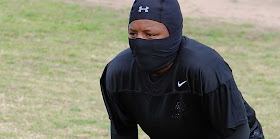In my last post I talked about getting low for power. The competitor who is lower has the advantage. To illustrate, I suggested you go out in the driveway and attempt to push your car. Remember?
 |
Just four Outlaws moving that truck. Lily did contribute
to the drill - she sat behind the wheel and steered.
And sometimes touched the brake a little just to
increase the challenge. |
Would you believe part of the practice today for Outlaws linewomen was pushing a car? Well, not a car, a small truck. Four ladies pushed that truck up and down the parking lot for a good thirty minutes. You will notice in the photo the natural way to gain maximum strength, maximum pushing power, is to get low.
Now Lily didn't do this drill because of my blog post. The Outlaws don't have a blocking sled and she cleverly came up with the push-a-truck drill as a reasonable facsimile. But I'll have to admit I did think very positive thoughts about myself in that I had suggested this idea as recently as yesterday.
Today I want to post some miscellaneous stuff from this morning's practice. I have one photo I can hardly wait for you to see. It is either funny or eerie. I'll let you decide. I said I can hardly wait but I'm going to wait until the end of the post. Going to put a little miscellaneous stuff first. Save the amazing funny eerie for last. In television they call that a tease.
There were some cool spectators at the practice today. I've learned I can look like a good photographer if I select good subjects.
 |
I love close-up candids. Not sure what she's thinking about
but she makes this post much better. |
 |
Pictures of kids always make me look like a good
photographer. It's my secret, don't tell anyone. I'm
really not very good. |
 |
I don't know the owner and apologize for making
this a picture of her dog. Cute little jacket.
It was cold again this weekend. |
 |
| Standing on rear legs for a better view of the practice. |
Early season practice is basically no-contact. No pads, no tackling, no blocking each other. Well, except for some blocking drills where one person holds a blocking pad and another hits it. If you've been to a pro game or close to the sideline at a college game you're aware of the sound of high-level football. There are guttural noises as strong people put out maximum effort. There's the sound of collisions. We call it pads popping but "popping" doesn't adequately express it.
The blocking drill I watched wasn't particularly remarkable until two seasoned and serious competitors got across from one another. Ski was holding the pad, Dikibo was hitting it. Now Dikibo appears to be a quiet, soft spoken, gentlewoman. Maybe she is. But when she started hitting the pads, there was some serious popping.
 |
We need a sound track with this photo. During the drill, Dikibo
hit Ski five times in a display of serious football. |
I'm surprised the blocking pad survived the hitting. There will be more on Dikibo and Ski in future posts.
 |
| Bobbie calling out words of encouragement. |
Speaking of the sounds of football,
this is Bobbie, one of the coaches. She is dynamic, energetic, full of fire and enthusiasm. I've never seen her eyes because of the bill of that cap she always wears, but I have heard her voice.
This reminds me of a poem about a church pastor:
"I never see my pastor's eyes,
He hides their light divine.
For when he prays he closes his
And when he preaches, mine."
That has absolutely nothing to do with the Outlaws but by now you've noticed I don't always stay on subject. I was saying, the Outlaws work hard at generating enthusiasm. Vocally. Loudly. It is part of the team DNA.
There's another player who is becoming one of my favorites. I don't remember her name. Please refer back to a post I did a few months ago, "In Case I Forget". But with or without her name I noticed she has that spark, that enthusiasm. I can't always hear what she's saying but... well, take a look at this photo:
 |
Calling for the ball? Or yelling "Outlaws" as the players
do every time they hear a whistle or break a huddle. Or
just doing a Tarzan yell to intimidate anyone who is
considering getting in her path. |
Does she have the spirit? I noticed she kept shouting as she ran her pass pattern. She was inspiring herself. She was inspiring others. And she did catch the ball - watch for that on a future blog post. Normally I shoot receivers when they get to the area where the pass will be thrown. In her case, I started following her early because I wanted to capture some of the fire.
And that led to my amazing eerie funny photo. The one I promised at the beginning of this posting. My new best friend was just doing what she does... well, wait. I think I'll just post the picture and see if you react the same way I did.
There was no man on the field. No man anywhere near the unnamed receiver. I don't know where this shadowy figure came from. I don't even know if he was really there.
Maybe you would like to explain it to me?

















































